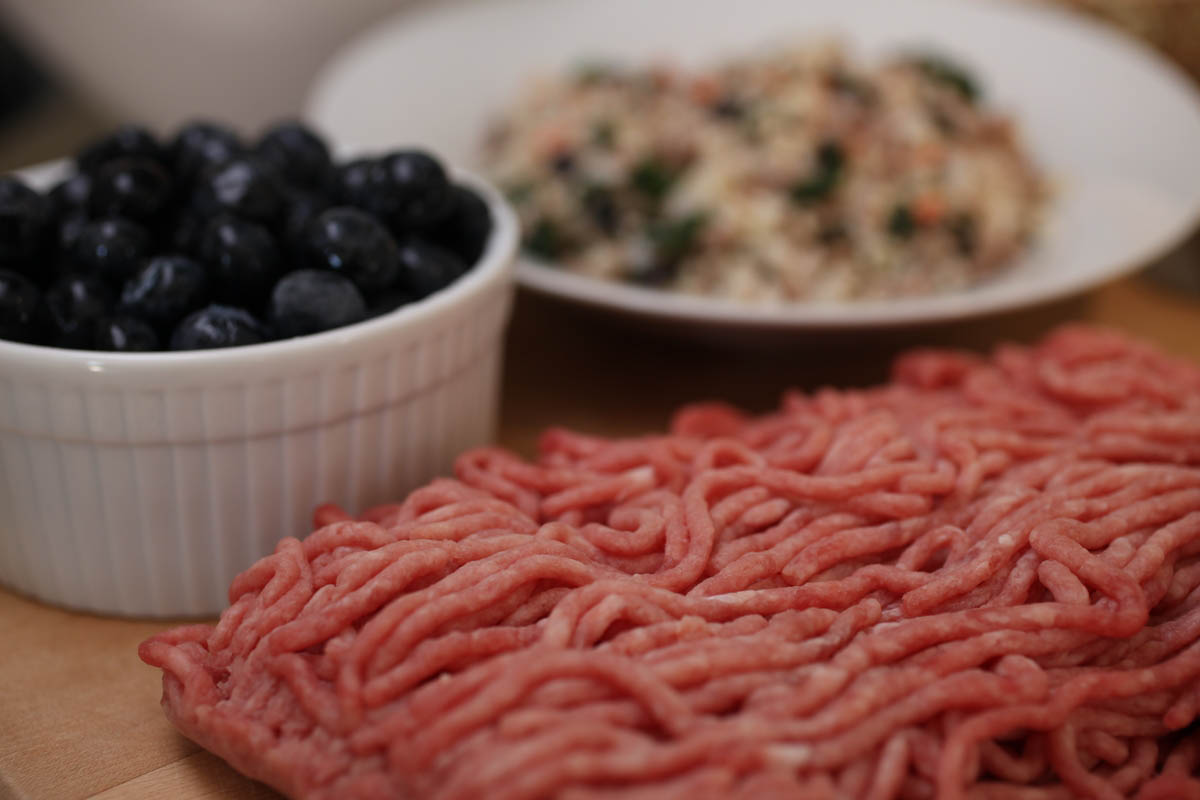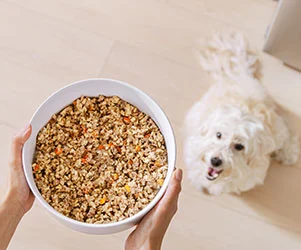Summary
-
Crude protein = estimated protein, not quality
-
It doesn’t tell you how digestible or complete the protein is
-
AAFCO recommends 18% (adult) and 22.5% (puppies) on a dry matter basis
-
Animal proteins are generally higher quality than plant-based ones
-
Protein needs vary by age, activity, and health
👉 Keep reading to learn how to spot high-quality protein and choose the right food for your dog’s unique needs.
If you’ve ever examined a dog food label, you’ve likely seen the term “crude protein” listed under the guaranteed analysis—a section on the packaging similar to a human nutrition label. But what is crude protein in dog food, and how does it affect your dog’s well-being?
Protein can feel like a buzzword in pet food marketing. You know your pup needs it, but is more truly better? In this post, we explain:
- What crude protein means
- How to evaluate protein listings on dog food labels
- How to choose a food that provides high-quality protein to support your pet’s health through all their life stages.
What is crude protein?
The term “crude protein” doesn’t mean the protein included in your pet’s food is raw or unrefined; it refers to the way scientists estimate the protein content in pet food. Crude protein is calculated by measuring the amount of nitrogen in the food. This is because amino acids—the building blocks of protein—contain nitrogen.
Crude protein tells you how much protein is in a particular food. What it doesn’t tell you is where it comes from or how well your dog can use it. To determine whether your dog’s current food meets their nutritional requirements, you’ll need to look beyond the number and consider the source of protein, its amino acid profile, and the overall nutritional value it provides.

Why do dogs need protein?
Dogs need protein to support vital body functions, including:
- Tissue growth and repair — Protein helps build and maintain muscle mass, organs, skin, and hair.
- Immune system function — Many components of the immune system, including antibodies and enzymes, are made from proteins.
- Energy production — While carbohydrates and fatty acids are the body’s primary energy sources, protein can step in when needed, especially for active dogs.
- Transport and hormone regulation — Proteins help shuttle nutrients through the body and regulate hormones, including those responsible for growth and metabolism.
All proteins are made up of amino acids in varying concentrations, some of which dogs cannot produce on their own and must consume in their diets. Dog food that contains all essential amino acids is considered to have a “complete” protein source.
Whether you’re feeding adult dogs, growing dogs, or senior dogs, the right protein balance supports a healthy dog from the inside out.
How much protein does your dog need?

The ideal amount of crude protein in dog food depends on several factors. They include your dog’s activity level, age, breed, and overall health.
According to the Association of American Feed Control Officials (AAFCO), adult maintenance diets must contain a minimum of 18% crude protein. In comparison, growth and reproduction formulas (e.g., puppy food) must contain at least 22.5%.
These numbers are based on dry matter calculations, which remove moisture content from the equation. You must calculate protein levels on a dry matter basis if you intend to compare pet foods in different forms (e.g., kibble, fresh, or canned).
Use this formula to convert crude protein into dry matter protein:
- Dry matter protein (%) = (Crude protein %) ÷ (100 – moisture %) × 100
So, for a food with 10% crude protein and 75% moisture:
- (10) / (100-75) x 100 = 40
- The food contains 40% protein on a dry matter basis.
Pet owners should note that even if a food meets AAFCO’s minimum nutrient standards, it may not equate to optimal nutrition. A healthy dog who’s highly active may benefit from a higher protein diet, while a dog with kidney disease or another medical condition may need a lower-protein formulation provided by a certified nutritionist or veterinarian.
Here’s a quick look at protein needs by life stage and lifestyle:
- Puppies and growing dogs require more protein to support rapid growth and development.
- Adult dogs need enough protein to maintain muscle mass and fuel daily activity.
- Senior dogs often benefit from increased protein to help prevent age-related muscle loss.
- Active dogs and working breeds burn more calories and may need extra protein for energy and recovery.
- Overweight dogs can try higher-protein, lower-carbohydrate diets, which may aid in weight loss while preserving lean body mass.
Foods that meet AAFCO minimum requirements for a specific nutrient profile (e.g., senior, puppy, adult) can be labeled with a statement that says the manufacturer complied with AAFCO’s published recommendations.
When evaluating a food, the presence of an AAFCO statement is a good starting point—but not the final word.
Look closely at the ingredient list, protein sources, and brand trustworthiness, then consult with your vet before trying something new—especially if your dog has any existing health problems.
Sources of protein in dog food
An adequate protein percentage in dog food doesn’t necessarily mean that the protein is digestible and usable by your pup’s body. To understand the quality of your dog’s food, you need to know where the protein comes from.
Most dog food relies on a mixture of animal and plant ingredients. While both can contribute to the total crude protein content, they’re not created equally regarding overall nutritional value.
Animal proteins contain all the essential amino acids dogs need to thrive. They are also easily digestible and biologically appropriate for dogs.
Plant-based ingredients, such as peas, chickpeas, soy, or corn, can enhance protein levels in dog food; however, many plant proteins lack one or more essential amino acids. Dogs cannot survive on a single plant protein alone, but a diet formulated with multiple plant-based proteins used together to cover nutritional gaps can support canine health.
When used in conjunction with animal proteins, plant ingredients can complement a recipe. Plant-based diets can provide crude protein alongside essential fiber and carbohydrates. However, overusing plant proteins can interfere with digestibility.
Crude protein in different dog food types
Dry dog food, including traditional kibble, typically contains little moisture and higher percentages of crude protein listed on the label. Canned or fresh-cooked diets (like those from JustFoodForDogs) contain considerably more moisture than kibble, which makes the protein percentage on the label appear lower.
Always remember to compare protein values on a dry matter basis when evaluating different food types. A fresh or wet food with 8% crude protein might sound low, but after accounting for moisture, it could be equivalent to or better than a kibble diet with 25% crude protein.
Other components of the guaranteed analysis, such as crude fat and crude fiber, can also influence your dog’s recommended food formulation and calorie intake. Protein is essential, but it’s only one part of a balanced diet.
How much protein does your dog need?
Every dog is different. A protein-packed formulation might be perfect for one dog but too rich for another. That’s why it’s essential to consider several factors, including your dog’s:
- Age and life stage – Puppy food and senior dog food should contain more protein to support growth and muscle maintenance, respectively.
- Activity level – Active dogs and working dogs require more calories.
- Health status – Dogs with medical conditions may benefit from modified protein levels under the guidance of a nutritionist or veterinarian.
- Weight goals – For dogs on a weight loss plan, a high-protein, low-carbohydrate diet can help preserve lean muscle while shedding fat.
More than a number
Crude protein is only one piece of the canine nutrition puzzle. Although you should be aware of the protein content in your pet’s diet, the food’s quality, amino acid composition, digestibility, and sourcing are also essential considerations. When in doubt, consult your veterinarian or a nutritionist who understands your dog’s needs.
At JustFoodForDogs, we believe that every dog deserves quality nutrition backed by science, made from ingredients you trust. Dog food with complete, high-quality protein designed for your dog’s life stage can support a longer, healthier life.
“The Association of American Feed Control Officials > Home.” 2018. Aafco.org. 2018. https://www.aafco.org/.
“A Science-Based Guide for Pet Owners.” 2006. https://nap.nationalacademies.org/resource/10668/dog_nutrition_final_fix.pdf.
This content is for informational use only and does not replace professional nutrition and/or medical advice, diagnosis, or treatment. It is not a substitute for and should not be relied upon for specific nutrition and/or medical recommendations. Please talk with your veterinarian about any questions or concerns.
Elizabeth Kowalski, CVT







